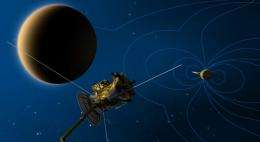Magnetic Dance of Titan and Saturn To Be Main Attraction during Flyby

(PhysOrg.com) -- When it flies by Saturn's largest moon, Titan, this weekend, NASA's Cassini spacecraft will study the interactions between the magnetic field of Saturn and Titan. The flyby will take place the evening of Dec. 11 California time, or shortly after midnight Universal Time on Dec. 12.
As Titan plows through the magnetic bubble, or magnetosphere around Saturn, it creates a wake in the magnetic field lines coming away from the planet. This flyby will allow Cassini's fields and particles instruments to study that wake about 5,200 kilometers (3,200 miles) away from the moon, a relatively unexamined region. Other instruments will also be taking a closer look at Titan's clouds.
At closest approach to Titan, Cassini will swing to within about 4,900 kilometers (3,000 miles) of the surface of the moon.
Cassini last zoomed by Titan two months ago. Although this latest flyby is dubbed "T63," planning changes early in the orbital tour have made this the sixty-fourth targeted flyby of Titan.
Titan is a kind of "sister world" to Earth because it has a surface covered with organic material and an atmosphere whose chemical composition hearkens back to an early Earth.
Provided by JPL/NASA (news : web)















